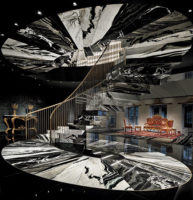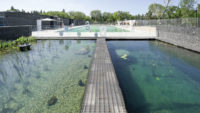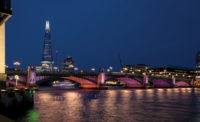All four classical elements combined to shape architect Hawkins\Brown’s new swimming pool for the City of London Freemen’s School, set in the grounds of a former country estate in Ashtead, a leafy suburb. The dark, low-slung building is partly embedded in the earth of its sloping site, minimizing its outward impact, but from the water swimmers enjoy the airiness of a light-filled enclosure whose pale wood portal frames arch overhead like the ribs of a gothic vault. And it was the fourth element—fire—that initiated the project, after the school’s previous pool building burned down in early 2014.
Additional Content:
Jump to credits & specifications
Hawkins\Brown had already embarked on a phased program of improvements to the private boarding school, whose main building dates back to the 17th century and is historically listed, along with the surrounding landscape. Replacement and relocation of the 1970s pool had been planned for later, in part to improve views of the historic house from its original driveway. However, the fire required a hasty reshuffling of the schedule.
With pressure to get the new $10.8 million facility operational, design decisions were made quickly. The most important was the choice of a glue-laminated timber frame braced by cross-laminated timber (CLT) panels. The material resonates with the chosen site, near the main house but screened from view by established trees. There were also practical reasons: off-site-manufactured timber buildings are fast and quiet to erect, and particularly appropriate to pools, says architect Harriet Redman: “Because wood is thermally insulating, there is less condensation and fewer maintenance requirements.”
To minimize heat loss, a compact volume was also desirable. Ancillary spaces are stacked over two stories at the southern end of the rectangular structure, with the entrance and a classroom at second-floor level, where the building meets high ground, and changing rooms below, sunk into the sloping bank. The orthogonal box was then inflected by a roof ridge that runs diagonally, so that the highest parts are above the entrance and the northwest corner of the pool hall, with the roof falling to the opposite two corners. On entering, the eye is drawn through an internal window into the pool hall, and follows the shifting apexes of the portal frames to its far corner, where wraparound glazing at poolside gives expansive views of the surrounding woodland.
“The shift in geometry is a straightforward move but makes a dramatic interior,” says Redman. “Once we’d locked that down, the main design challenge was in the detailing.” Here the effort was to maintain the apparent simplicity—a complicated task given the functional and environmental requirements of pools.
Visible evidence of mechanical and electrical equipment has been successfully minimized. A plenum wraps the pool tank below deck, through which warm pressurized air is pumped. This washes over the glazing, via discreet grilles set into the timber structure, to prevent condensation. All lighting and electrical systems are gathered in a wooden header above the windows that line three sides of the 25-meter (82-foot), six-lane pool. The bottom of the glazing drops below the edge of the pool deck, which is level with the water, so swimmers have direct views into the trees. Spectator seating is accommodated within the depth of the frame and fashioned from CLT.
Hawkins\Brown was also able to meet strict standards for competition pools without deviating from the building’s minimal architectural language. One rule, for example, requires ceiling markings to orient backstroke swimmers, so the CLT roof panels are laid with their subtly visible grain and joints running perpendicular to the glulam frames, parallel to the lanes.
Simplicity also characterizes the design of the facades and the surrounding landscape, both of which are intended to allow the building to merge with its setting. The lower story is faced in fiber-cement board, while the upper parts are clad in standing-seam zinc. Both materials are in shades of brown, to blend in with bare trees in the winter.
In the summer, the leafy woodland provides camouflage, now supplemented by two new trees for every one removed to make way for the structure. A planting plan by B|D Landscape Architects “is very subtle,” says Redman. “There are no big moves; as with the building, we didn’t want to do anything that was louder than the surrounding woodland.” Containers filled with lavender step down the sides of the building, and the forest’s understory has been filled out with ferns and flowering bulbs.
Just as the dark exterior allows the building to recede from view, so the pale, unfussy interior directs attention to splashes of color inside and out—azure water and green landscape— creating the sense, as Hawkins\Brown partner Adam Cossey suggests, that one is “swimming amongst the trees.”
CreditsArchitect: Hawkins\Brown — Oliver Milton, Adam Cossey, Harriet Redman
Consultants: Eckersley O’Callaghan (structural); Skelly and Couch (building services); Motion Consultants (transport); B|D Landscape Architects (landscape); Aspect (ecology); Treeline (arboriculture)
General contractor: Gilbert-Ash |
SpecificationsGlulam and CLT WeiHag
Standing seam metal ElZinc
Curtain wall Aluprof
GRC panels Marley Eternit, Equitone
Acoustical ceilings ToughSorba
Lighting Thorlux, Solow, Lucis, Diadem
Timber whitewash HSP Envirograf |










Post a comment to this article
Report Abusive Comment